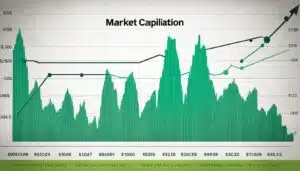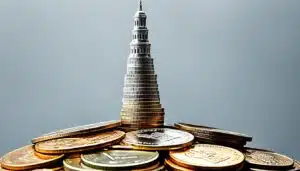The market capitalization, or market cap, shows the total value of a company’s stock. It works by multiplying a company’s outstanding shares by their current share price. It’s super important for investors to know this for investment.
Companies fall into three buckets: large-cap, mid-cap, and small-cap. This is based on their market capitalisation. Large-cap firms are very solid. But small-cap ones can grow faster, with more risk. Balancing these in your investment portfolio is key.

Key Takeaways
- Market capitalisation, or market cap, shows a company’s total stock value.
- Companies are put into large-cap, mid-cap, or small-cap groups by how big they are.
- Big companies are usually safer, while smaller ones might grow more but are riskier.
- It’s important to look at a company’s market cap for a varied investment plan.
- To find the market cap, multiply a company’s outstanding shares by its share price.
Understanding Market Capitalization
Market capitalization, or “market cap,” is the total worth of a company’s shares. Investors use it to gauge a company’s scope and value for investment. To figure out market cap, we multiply the company’s shares by the share’s current price.
Definition of Market Capitalization
Market capitalization shows a company’s total worth using its share prices. Investors find it useful for comparing companies. Bigger companies are seen as lower risk because of their higher market caps.
How to Calculate Market Cap
To find market cap, you must have the total shares and the share price. It’s easy to calculate:
Market Capitalisation = Total Outstanding Shares x Current Share Price
For a clearer picture: consider a company with 50 million shares at $50 each. Its market cap would be $2.5 billion (50 million shares x $50 price per share).
Market Capitalisation and Company Size
In the stock market, market capitalization is key for understanding companies. It shows the total value of a company’s shares. This helps us categorize companies by size, which affects their risk and growth potential.
Large-Cap Companies
Large-cap companies are very big, worth over $10 billion. They are stable and include big names like Microsoft and Johnson & Johnson. Even though they offer less growth, large-caps are seen as safe bets by investors precisely for that stability they provide.
Mid-Cap Companies
Mid-cap companies are in the middle in terms of size, from $2 billion to $10 billion. They’re growing and offer more chance for growth than large-caps. However, they are less risky than smaller companies, making them a good compromise for many investors.
Small-Cap Companies
Small-cap companies are on the smaller side, with a value between $250 million and $2 billion. They are often young and innovative. This means they have the potential for high growth, but they are riskier because of their size and market volatility.
Investors often balance their portfolios with a mix of large, mid, and small companies. This can help in managing risk while aiming for growth. It’s all about what fits with their own investment goals and how much risk they’re willing to take.

| Market Capitalization Segment | Market Cap Range | Characteristics |
|---|---|---|
| Large-Cap | $10 billion or more | Well-established, mature companies; more stable and less volatile; lower risk and growth potential |
| Mid-Cap | $2 billion to $10 billion | Growing companies; balance between stability and growth potential; moderate risk and returns |
| Small-Cap | $250 million to $2 billion | Younger, more innovative companies; higher growth potential but also higher volatility; higher risk and returns |
Importance of Market Capitalization
Market capitalization is vital for investors. It shows a company’s size, growth stage, and risk-return profile. By categorizing companies as large-cap, mid-cap, or small-cap, it helps investors know about the growth potential and volatility of different sized firms.
To find the market cap of a company, you multiply the number of outstanding shares by the current share price. This gives the total market value of the company’s stock price. It’s key for investors to know this when creating a diverse portfolio. Knowing a company’s market capitalization is critical for understanding its equity valuation, corporate valuation, and shareholder equity.
Looking at a company’s market cap also tells you about its growth potential and risk profile. For example, large-cap companies over $10 billion are often seen as stable. On the other hand, small-cap companies under $2 billion might grow more but have higher risk. Mid-cap companies fall in the middle, from $2 billion to $10 billion.
At the end, market capitalization is key for investors. It tells them about a company’s value, its stock market value, and its position in the investment landscape. Looking at a company’s market cap helps investors make smarter choices when building their investment portfolios.

Risk and Return Potential Based on Market Cap
Market capitalization is key to see how risky or rewarding a stock is. We’ll look at large-cap, mid-cap, and small-cap stocks. Each kind affects your investments differently.
Large-Cap Stocks: Stability and Dividend Payouts
Large-cap stocks are from big, stable companies with $10 billion or more in value. They’re less risky and known for paying regular dividends. While they might not grow as fast as small companies, they offer a steadier income for cautious investors.
Mid-Cap Stocks: Growth Potential with Moderate Risk
Mid-cap stocks fall between $2 billion and $10 billion in value. They’re usually growing and have new opportunities for expansion. They’re riskier than large-caps but can boost your portfolio with good returns and variety.
Small-Cap Stocks: High Growth Potential, High Volatility
Small-cap stocks are from companies valued at $250 million to $2 billion. They promise big growth but are also quite risky. Often, they are new or in a niche, which might lead to fast increases. But, they can swing a lot in value, which is not for everyone.
| Market Cap Category | Market Cap Range | Characteristics | Risk and Return Potential |
|---|---|---|---|
| Large-Cap Stocks | $10 billion or more | Established, stable companies; often household names | Lower risk, lower growth potential; may offer consistent dividend payouts |
| Mid-Cap Stocks | $2 billion to $10 billion | Growing companies with expansion opportunities | Moderate risk, moderate growth potential |
| Small-Cap Stocks | $250 million to $2 billion | Smaller, often younger companies; may operate in niche markets | Higher risk, higher growth potential |

Building a Diversified Portfolio with Market Caps
Creating an investment portfolio needs a good mix of large, mid, and small-cap stocks. This mix balances risk and returns. It means your investment can handle market ups and downs well.
Balancing Risk and Return with Market Caps
Large-cap stocks have lots of shares out there, valued over $10 billion. They’re known for being stable. They also pay out dividends regularly, which is good for people who don’t like a lot of risk.
Small-caps, with their size between $250 million and $2 billion, offer a chance for bigger growth. But they can also be more uncertain. Then you have mid-caps, worth between $2 billion and $10 billion. They sit in the middle, balancing growth with some level of risk.
Also read : Exploring The Charm Of Vintage Stock
Asset Allocation and Market Caps
Adding large, mid, and small-cap stocks to your portfolio is smart. It spreads out your risk. Large-caps keep things steady, mid-caps bring growth opportunities, and small-caps add more growth chances.
This mix can soften any big hits from one part of the market. It could also help make your investments do better in the long run.

Market Cap Segments and Indexes
Market capitalization is key to understanding where to invest. Stocks are placed into groups by their market cap. This helps investors see the risks and rewards of various companies.
S&P 500 and Large-Cap Stocks
The S&P 500 follows the biggest U.S. stocks. These companies are familiar names and valued at over $10 billion. Investing in S&P 500-related funds like ETFs can diversify your holdings. This mix can offer both stability and chances for growth.
Mid-Cap and Small-Cap Indexes
Besides large-cap stocks, there are indexes for mid-cap and small-cap companies. Mid-cap stocks are worth between $2 billion and $10 billion. They balance growth chances with moderate risks. Small-cap stocks are valued between $250 million and $2 billion. They offer more growth but can be riskier. Including mutual fund that mirror these indexes can improve your overall returns through diversification. Investors may have different perspectives on the potential of a stock, leading to varying opinions on its future performance.

Market Capitalisation vs. Float-Adjusted Market Cap
Market capitalization shows a company’s total value by all outstanding shares. But float-adjusted market cap looks at what’s actually available to the public. This means it excludes shares owned by insiders, institutions, or the government. Investors look at the S&P 500 or Dow Jones Industrial Average. They use the float-adjusted cap to see a true picture.
Float-adjusted market cap gives a better picture of a company’s real value and how easily its shares can be bought or sold in the market. It’s key for index funds and exchange-traded funds (ETFs) to accurately invest in companies. This way, they match what the market is really valuing.
Knowing the difference between market capitalization and float-adjusted market cap helps in figuring out a company’s size and worth. Both metrics are useful. But float-adjusted market cap offers a more detailed look at a company’s true worth and how it trades.
FAQs
Q: What is market capitalisation?
A: Market capitalisation, also known as market cap, is the total value of a company’s outstanding shares of stock. It is calculated by multiplying the current market price of a single share by the total number of shares outstanding.
Q: Why does market capitalisation matter?
A: Market capitalisation is used to determine the size and value of a company in the stock market. It is also used to describe the different categories of companies, such as large caps, mid caps, and small caps, based on their market cap value.
Q: How is market capitalisation calculated?
A: Market capitalisation is calculated by multiplying the current market price of one share by the total number of outstanding shares. This formula helps investors understand the total value of a company in the stock market.
Q: What is a free-float market cap?
A: Free-float market cap is a type of market capitalisation that takes into account only the shares of stock available for trading in the market. It excludes locked-in shares held by company insiders or large stakeholders.
Q: Why do high market cap companies matter?
A: Companies with high market capitalisations are often established, publicly traded companies with less growth potential compared to smaller companies. Investors may view high market cap companies as more stable and less risky investments.
Q: How is market cap used in stock indexes?
A: Market capitalisation is used to determine the weighting of individual companies in stock indexes. Companies with larger market caps will have a greater influence on the movement of the overall index.
Q: What is the market cap formula?
A: The market capitalisation formula is calculated by multiplying the current market price of one share by the total number of outstanding shares. This formula provides investors with insights into the valuation of a company in the stock market.





